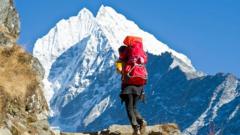Nepal's tourism sector, heavily reliant on mountaineering, generated $5.9 million in revenue last year, with a significant portion coming from Everest climbs. Starting September, the permit fees for Everest will rise to $15,000, the first increase in nearly ten years, as Nepal's Tourism Department attempts to alleviate the crowding issue on the world’s highest peak.
The newly accessible peaks, which range from 5,970m to 7,132m, are predominantly located in the impoverished Karnali and Sudurpaschim provinces, areas that historically see minimal tourist traffic due to challenging access routes. Himal Gautam, director of Nepal’s Tourism Department, expressed hope that this initiative will both increase job opportunities and invigorate the local economy, asserting that the stunning landscapes of these regions merit greater attention.
However, concerns linger regarding infrastructure development and the ability of local communities to manage an influx of climbers. So far, only a handful of climbers have shown interest in these remote summits, with just 68 permits issued for these peaks in the last two years, as compared to over 400 permits for Everest in 2024 alone.
In response to the environmental impact and safety issues surrounding Everest climbs, Nepal's Supreme Court has mandated limits on climbing permits, calling for more responsible mountaineering practices. The government is also considering a legal requirement for Everest climbers to have previously ascended a mountain exceeding 7,000m in Nepal, which could promote the newly available peaks as ideal training grounds for aspiring climbers.
As the cost of climbing Everest continues to rise along with the regulatory measures, the free climbing initiative may provide an essential opportunity to redistribute the climbing enthusiasm across Nepal’s majestic mountains, offering a fresh experience for adventurers and supporting local economic resilience.
The newly accessible peaks, which range from 5,970m to 7,132m, are predominantly located in the impoverished Karnali and Sudurpaschim provinces, areas that historically see minimal tourist traffic due to challenging access routes. Himal Gautam, director of Nepal’s Tourism Department, expressed hope that this initiative will both increase job opportunities and invigorate the local economy, asserting that the stunning landscapes of these regions merit greater attention.
However, concerns linger regarding infrastructure development and the ability of local communities to manage an influx of climbers. So far, only a handful of climbers have shown interest in these remote summits, with just 68 permits issued for these peaks in the last two years, as compared to over 400 permits for Everest in 2024 alone.
In response to the environmental impact and safety issues surrounding Everest climbs, Nepal's Supreme Court has mandated limits on climbing permits, calling for more responsible mountaineering practices. The government is also considering a legal requirement for Everest climbers to have previously ascended a mountain exceeding 7,000m in Nepal, which could promote the newly available peaks as ideal training grounds for aspiring climbers.
As the cost of climbing Everest continues to rise along with the regulatory measures, the free climbing initiative may provide an essential opportunity to redistribute the climbing enthusiasm across Nepal’s majestic mountains, offering a fresh experience for adventurers and supporting local economic resilience.




















